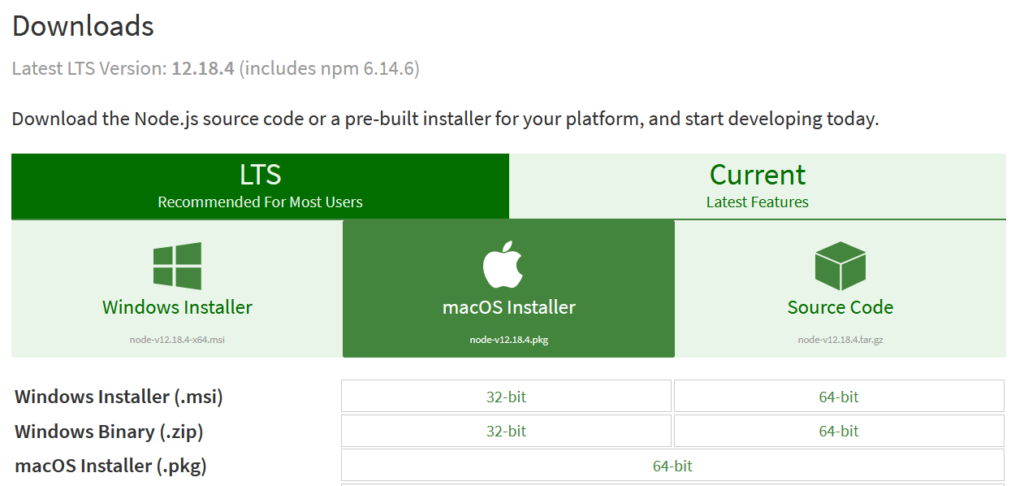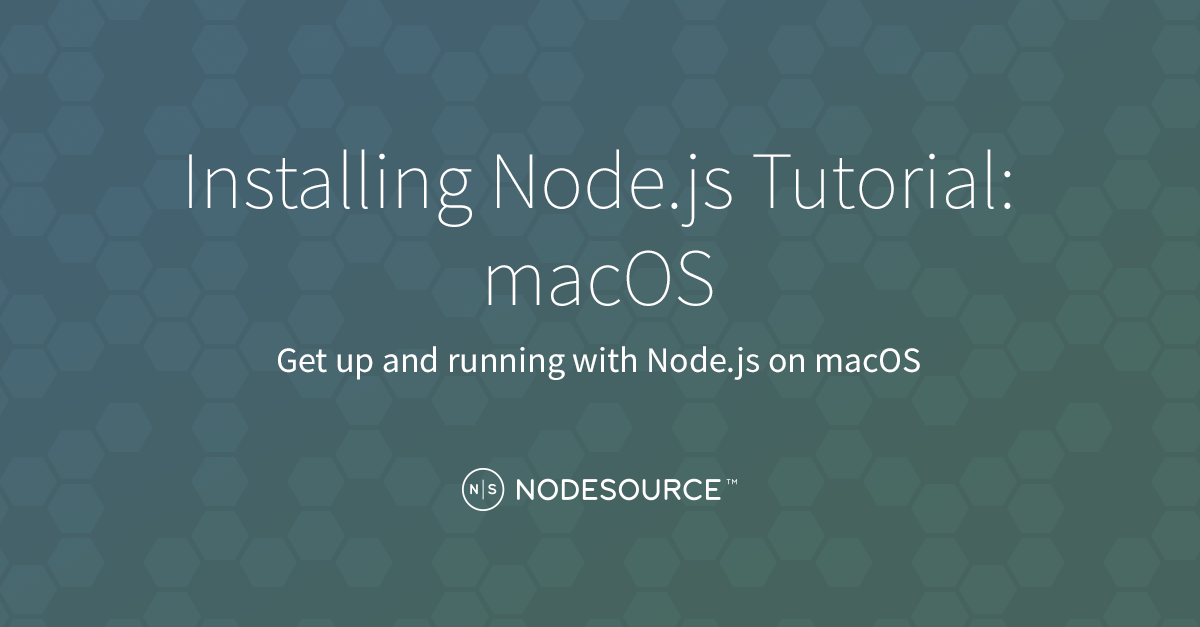Nssm install node path js path eg: nssm install myservice 'C: Program Files odejs' 'C: myapp app.js' this will install a new windows service which will be listed at services.msc from there you can start or stop the service, this service will auto start and you can configure to restart if it fails. Install Node.js (node 10.16.x LTS is a bare minimum, node 12 and 13 have some great performance benfits.) for more help, check out Installing Node.JS on different platforms. Install AutoRest using npm #.
-->Install Nodejs Osx
Browse other questions tagged node.js node-gyp or ask your own question. The Overflow Blog Podcast 323: A director of engineering explains scaling from dozens of. Install node.js. Node.js is a JavaScript runtime built on Chrome's V8 JavaScript engine. It allows developers to run any apps created on JavaScript. To install node.js, in a web browser, navigate to node.js. Download the latest MSI installer. Run the installer, and then follow the installation steps.

In this article, you'll learn how to set up your environment for developing a Power BI visual.
Before you start development, you'll need to install node.js and the pbiviz package. You'll also need to create and install a certificate. When your local environment is set up, you'll need to configure Power BI service for developing a Power BI visual.
In this article, you'll learn how to:
- Install nodes.js.
- Install pbiviz.
- Create and install a certificate.
- Set up Power BI service for developing a visual.
- Install additional libraries (required for developing a visual).
Install node.js
Node.js is a JavaScript runtime built on Chrome's V8 JavaScript engine. It allows developers to run any apps created on JavaScript.
To install node.js, in a web browser, navigate to node.js.
Download the latest MSI installer.
Run the installer, and then follow the installation steps. Accept the terms of the license agreement and all defaults.
Restart your computer.
Install pbiviz
The pbiviz tool, which is written using JavaScript, compiles the visual source code of the pbiviz package.
The pbiviz package is a zipped Power BI visual project, with all the needed scripts and assets.
Open Windows PowerShell and enter the following command.
Create and install a certificate

For a client (your computer) and a server (Power BI service) to interact securely, a Secure Sockets Layer (SSL) Certificate is required. Without a certificate to ensure secure interactions, they will be blocked by the browser.
This process describes running a PowerShell command that launches the Certificate Import Wizard. Follow the steps below to configure the certificate in the wizard.
Important
Do not close the PowerShell window during this procedure.
Open Windows PowerShell and enter the following command.
This command does two things:
- It returns a passphrase. In this case, the passphrase is 9765328806094.
- It also starts the Certificate Import Wizard.
In the Certificate Import Wizard, verify that the store location is set to Current User, and select Next.
In the File to Import window, select Next.
In the Private Key Protection window, in the Password text box, paste the passphrase you received when executing the PowerShell command (step 1) and select Next. In this example, the passphrase is 9765328806094.
In the Certificate Store window, select the Place all certificates in the following store option, and select Browse.
In the Select Certificate Store window, select Trusted Root Certification Authorities and then select OK. Mac office 2011 uninstall.
Select Next in the Certificate Store window.
In the Completing the Certificate Import Wizard window, verify your settings and select Finish.
Note
If you receive a security warning, select Yes.
If the lock in the upper left is locked, select it to unlock it. Search for localhost and double-click the certificate.
Select Always Trust and close the window.
Enter your username and password, and select Update Settings.
Close any browsers that you have open.
Note
If the certificate is not recognized, restart your computer.
(Optional) Verify that your environment is set up
Confirm that the Power BI visuals tools package is installed. In PowerShell, run the command pbiviz and review the output, including the list of supported commands.
Set up Power BI service for developing a visual

To develop a Power BI visual, you'll need to enable custom visual debugging in Power BI service. Follow the instructions in this section to enable this option.
Sign in to PowerBI.com.
Navigate to Settings > Settings > Settings.
From the General tab, select Developer. In the Developer Settings select the Enable custom visual debugging using the developer visual check box, and select Apply.

Install development libraries
To develop your own Power BI visual, you'll need to install additional libraries. This section describes how to install these libraries and verify that the installation is successful.
To install the libraries listed in this article, open PowerShell and enter the installation command for each component.
Note
Once these libraries are installed on your computer, you'll be able to use them for any Power BI visuals project. This is a one time installation procedure, per machine.
D3 JavaScript library
D3 is a JavaScript library for producing dynamic, interactive data visualizations in web browsers. It relies on widely implemented Scalable Vector Graphics (SVG), HTML5, and CSS standards.
TypeScript definitions
Install TypeScript definitions so that you can develop your Power BI visual in TypeScript, a superset of JavaScript.
Install Node Js Mac Without Admin
core-js
core-js is a modular standard library for JavaScript that includes polyfills for ECMAScript.
powerbi-visual-api
Install the Power BI Visuals API definitions.
(Optional) Verify that the D3 library is installed
Visual Studio Code (VS Code) is an ideal Integrated Development Environment (IDE) for developing TypeScript applications. In this section, we'll use VS Code to verify that the D3 library you need to develop your Power BI visual, is correctly installed.
Note
The verification process described in this section assumes you have an existing Power BI visuals project. Brew osx 10.15. If you don't have a Power BI visuals project, you can create one by following the circle card project creation instructions.
Open VS Code.
Tip
You can open VS Code from PowerShell by executing the following command:
In VS Code, open the File menu and select Open Folder.
In the Open Folder window, select the folder that contains your Power BI visual project, and select Select Folder.
In the Explorer pane, expand the node_modules folder and verify that the d3 library is installed.
In the Explorer pane, expand node_modules > @types > d3 and verify that the file index.t.ds is installed.
Next steps
